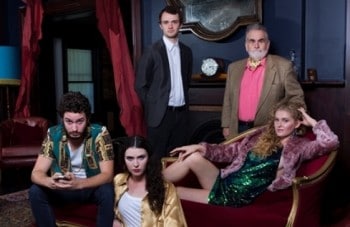The School for Scandal, New Theatre
In the preface to my copy, it says The School for Scandal is “often considered the apex of English comedy”. A bit of an overstatement no doubt, yet New Theatre rises to the task with an energetic appropriation that is both funny and well put together.
Writer R.B. Sheridan was a product of his age and The School for Scandal could be thought of as the 18th century’s answer to modern-day sitcoms. Essentially, the play is a pointed lampoon of the gossiping aristocrats within Sheridan’s social circle as well as a moralistic tale chiding their vices.
At the helm of New Theatre’s production, David Burrowes directs a re-contextualised version of the play. Taking the original dialogue and pairing it with 21st century paraphernalia, costumes, props and music, Burrowes aims to create a The Hills-cum-Romeo & Juliet à la Baz Luhrmann sort of pastiche. The plotline remains the same by and large, but instead of Georgian upper class toffs we follow the lives of a bunch of modern-day rich brats.

There’s plenty to laugh at and Burrowes has directed a tight performance – such techniques as his use of soliloquies as frozen moments in time added comic frisson. Along with Dramaturge Michael Collins, Burrowes has tweaked the play enough to give it a context resplendent in the design elements that audiences will find more familiar.
But then there’s the downfall – I couldn’t help feel either one contemporises a play completely and totally reworks the dialogue (think: 10 Things I Hate About You) or one retains the dialogue in its totality and reworks the setting.
Burrowes and Collins aim for Baz Luhrmann yet end up tinkering with Sheridan’s Georgian vernacular and sense of humour. The result is kind of enervating, we’re left with the promise of Sheridan’s wit without the chance to ever see it fully expressed.
The sharp undercurrent of anti-Semitism, which a good portion of the second act’s humour rests on, was entirely erased and at times even the actors themselves seemed a little bewildered by the language they were supposed to be using.
It’s understandable that a play should be relatable to the audience, but then isn’t that why The School for Scandal is a canon of English comedy, because its laughs are timeless?
Nonetheless there were standout performances that brought the comedy to life.
Rhys Keir as Charles Surface and Jacob Warner as Joseph Surface were both well at ease in Sheridan’s vernacular and endowed their characters with a unique gravitas. Both were able to manipulate their delivery so that, despite the archaic language, they expressed themselves clearly – we understood exactly what they were saying at all times.
Emma Harvie across the board was a highlight. She played a drôle and glum servant, almost the female equivalent of Baldrick from Black Adder, and her performance created comic tension in scenes that may lacked laughs otherwise.
In general the servant chorus did a sterling job – Nick Rowe’s Trip was another notable portrayal. Rowe dons Adidas trackpants, playing a sort of cockney lay-about with his head into the cocaine in an excellent remoulding of the character of Trip.
Madeleine Withington as Lady Teazle gave a strong Holly-Go-Lightly feel to her role that juxtaposed well with Marty O’Neill’s portrayal of Sir Peter Teazle. Plagued by his wife, O’Neill lent authenticity to his character’s hallmark platitude, “[w]hen an old bachelor marries a young wife, he deserves… no… the crime carries its punishment along with it”.
In terms of design elements, scene changes were a masterstroke. Sound Designer Ryan Devlin uses blaring rap and contemporary hip-hop reminiscent of 2 Chainz and Belief & Karnegie as leitmotifs at the curtains-up moment of every scene. The technique created a palpable energy.
Lighting under Alex Berlage was a general stage wash that balanced well with the all-purpose set.
Stripped down to white-wash walls and a cluster of idiosyncratic furnishings to help distinguish between the locations, the set itself was minimalist. Production Designer Isabella Andronos cleverly contrasted different scenes using symbolism. Charles Surfaces sitting room, for example, is bare but for a lonesome chair – the manifestation of his past “extravagance” and present “dissipated” fortunes.
Having attended opening night, I expect the cast will only grow more relaxed and into their roles as the production rolls on. Once they have, The School for Scandal will come closer to what Burrowes and Collins intended – a Baz Luhrman pastiche – and the jokes and humour that are still preserved will mean a devilishly funny play.
We saw the potential for this in the second act on opening night, where the actors onstage were more comfortable and the dialogue more free flowing – it did mean that the second act was by far more mirth-inducing than the first.
All in all, it’s an enjoyable piece of comic theatre that is recommended one go see – if not as a canon of English comedy then as a modern appropriation that despite its shortcomings still hits the mark.



